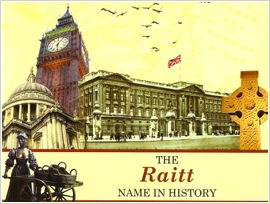The Raitt name in history
The Raitt name in history (by Ancestry.com and co.uk). Published by The Generations Network, 2008.
I finally succumbed and bought this book (which despite its modest size was not exactly cheap) out of curiosity but against my better judgement and I was right – it simply is not worth buying since it provides nothing of substance and is mostly irrelevant to anyone named Raitt. I have since discovered there are many other titles in the series (The X name in history) – including one for the name Rait – and I know they will all be virtually identical. I think it is an absolute con and people who don’t know much about their family history will be sorely disappointed. I mean how can there be two separate books for the names Raitt and Rait (and possibly also Raite or Reat) when anyone working in the field of genealogy (as Ancestry most certainly is) must know the names are synonymous? And anyone would also know that the name is Scottish – yet most of the data in the book refers to England and Wales (e.g in 1984 there were four registered marriages in England and Wales where one party had the name Raitt and in 2005 there were five Raitt births in England and Wales and four deaths – were there no Raitts born, married or died in Scotland or elsewhere in the world?!). The most common Raitt boys and girls names between 1838-1910 are taken from the English and Welsh BMD registers, not the Scottish ones.
The book says the name derives from a place called Rait in Perthshire and it is a variant of Raith (I bet there is also a book on the Raith name in history – which will be identical) and then for some reason it goes on to give German/Swiss topographic name derivations for Raith (not Raitt). Newbies might take this as gospel! Then there is a chunk about surnames (especially Dutch and Scandinavian) and how a snooker player changed his name. Who cares? Tell me about Raitt surnames. I don’t want to read about how some bloke called Harden emigrated from Leicestershire to the United States in 1866, I want to read about Raitts who emigrated. Why I should need to know the family lifestyle of Sir Richard Griffin, a Dublin-based geologist, is beyond me. Between 1261-1900 there was one Raitt alumni at Cambridge University (none at Oxford), but there is no mention of all those ministers of the cloth named Rait(t) who graduated from Aberdeen and other Scottish Universities – or indeed any other worldwide (oh wait – maybe they are in the Rait book instead – though I am willing to bet not).
Some of the information given, whilst pertaining mostly to England, does give, I suppose, a background to the situation elsewhere in the UK, including Scotland – for instance, the Depression or working conditions, and maybe the emigration of Mr Harden does show how our Raitt ancestors might have fared on a similar voyage. But much of the detail given is not useful for Raitts, nor has it been sensibly edited. Occupations in England in 1881 (why England and not Scotland – when a map does show the distribution of the name in Scotland?) gives work titles such as farmer’s daughter, farmers daur, farmer’s son, crofter’s wife. Relationships are not occupations (even if they can be hard work!)
The book does give some statistics on Raitt name distribution in Canada, Australia and the USA – but it is pretty basic and taken from censuses and other rolls. Regarding distribution of Raitt inhabitants in 1901 in the UK, the most populous county is Angus, followed by Aberdeen – these two were also the top birthplace counties. So it comes as a surprise to see a few pages later that the most Raitt births by county between 1984-2005 were all in England. And although there are two pages on Coats of Arms, those of Raitt are not mentioned. The book concludes with some 20 pages on how to research your family history and organize the information - and this will be common to all the books and is a complete waste of paper for most researchers.
All in all this is not really a book for any serious family history buff who has already done some work on the family name. The content cannot be trusted since it refers mainly to only English and Welsh (not known as a bastion of the Raitts) sources and no effort has gone in to verifying the facts. And it is full of extraneous information that adds precious little to the Raitt name in history. It would be interesting to see whether the Ancestry.com version differs from that offered by Ancestry.co.uk – if it does (e.g. if the American version provides details on popular names in America and Raitt births in counties in US States) then that is another reason to complain because the buyer/reader is not getting a fully comprehensive overview of the Raitt name in history.
Saturday, 21 January 2012

